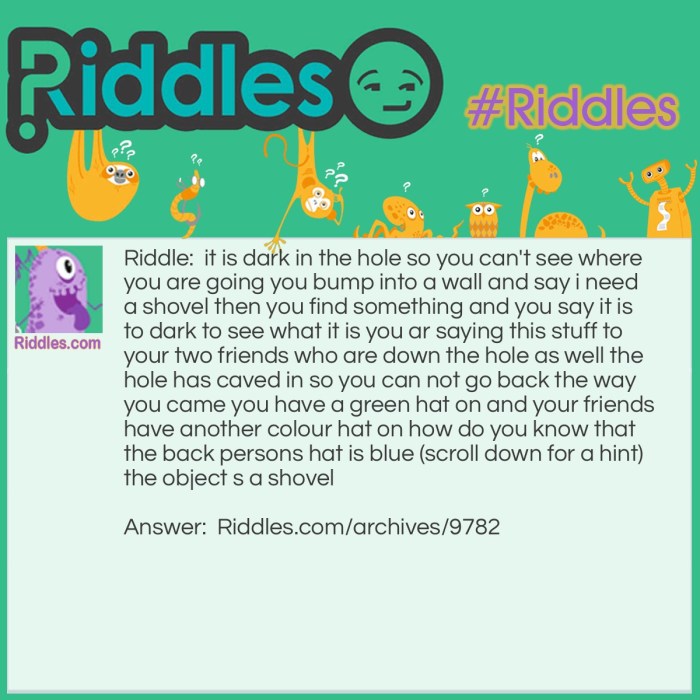Prepare to unravel the enigmatic world of story with a hole riddles, where logical deduction and lateral thinking collide. These riddles, with their captivating narratives and elusive answers, have captivated minds for centuries, inviting us to embark on a journey of problem-solving and discovery.
From their historical origins to their cognitive benefits, story with a hole riddles offer a unique blend of entertainment and intellectual stimulation. Join us as we delve into the intricacies of these riddles, exploring their types, methods of solution, and the profound impact they have on our minds.
Story with a Hole Riddle Examples
Story with a hole riddles are a type of riddle that involves a story with a missing piece. The solver must figure out what is missing from the story in order to solve the riddle.
Here is a table with four columns of examples of story with a hole riddles:
| Riddle | Answer | Explanation |
|---|---|---|
| What has a bed but no head, a mouth but no teeth, and runs but never walks? | A river | A river has a bed (the riverbed), a mouth (the place where it meets the ocean), and runs (the water flows), but it does not have a head, teeth, or legs to walk. |
| What has a neck but no head, arms but no hands, and a body but no legs? | A shirt | A shirt has a neck, arms, and a body, but it does not have a head, hands, or legs. |
| What has a face but no eyes, a nose but no mouth, and ears but no hearing? | A clock | A clock has a face, a nose (the hour hand), and ears (the minute and second hands), but it does not have eyes, a mouth, or the ability to hear. |
| What has a key but no lock, a space but no room, and you can enter but can’t go outside? | A keyboard | A keyboard has a key (the keys you press), a space (the space bar), and you can enter (type), but you can’t go outside (leave the keyboard). |
Methods for Solving Story with a Hole Riddles

Solving story with a hole riddles requires a combination of logical reasoning, visualization, and lateral thinking. By identifying key elements and applying these techniques, one can uncover the hidden meaning behind the riddle.
Key Elements
- Identifying the missing piece or “hole” in the story.
- Understanding the context and relationships between characters and events.
- Recognizing any clues or hints provided in the riddle.
Logical Reasoning
Logical reasoning involves applying deductive and inductive logic to the riddle. By examining the given information, one can eliminate impossible scenarios and narrow down the possibilities for the missing piece.
Visualization
Visualization is a powerful tool in solving story with a hole riddles. By creating a mental image of the story, one can better understand the relationships between characters and events, and identify potential missing pieces.
Lateral Thinking
Lateral thinking encourages one to think outside the box and consider unconventional solutions. By approaching the riddle from different perspectives and exploring alternative possibilities, one can often uncover the hidden meaning.
Types of Story with a Hole Riddles

Story with a hole riddles can be broadly classified into two main types: riddles that focus on a missing object or piece of information, and riddles that focus on a missing character or element in a story.
Missing Object or Information
These riddles present a story with a hole where a specific object or piece of information is missing. The solver must identify the missing element based on the clues provided in the riddle.
Example: “I am a part of a plant, but I am not a leaf or a stem. I am often hidden, but I am always there. What am I?” (Answer: A root)
Missing Character or Element, Story with a hole riddles
These riddles present a story with a missing character or element that is essential to the story’s progression or resolution. The solver must determine the identity of the missing element or character based on the clues provided in the riddle.
Example: “There was a man who lived in a house with four walls. All four walls were facing south. A bear came up to the house. What color was the bear?” (Answer: White, because the man is at the North Pole)
Both types of story with a hole riddles share the common goal of presenting a puzzle that requires the solver to fill in the missing information or element to complete the story.
Origins and History of Story with a Hole Riddles

The origins of story with a hole riddles remain shrouded in mystery, but their existence has been documented across various cultures and civilizations. These riddles have likely been passed down through oral traditions for centuries, with each generation adding their own variations and interpretations.
In ancient Greece, riddles were a popular form of entertainment and intellectual exercise. The Sphinx’s riddle in the Oedipus myth is one of the most famous examples of a story with a hole riddle. In medieval Europe, riddles were often used to test the wit and wisdom of knights and scholars.
The Exeter Book, an Anglo-Saxon manuscript from the 10th century, contains a collection of over 90 riddles, many of which feature a hole as a central element.
Cultural Impact
Story with a hole riddles have had a significant cultural impact throughout history. They have been used to teach lessons, entertain audiences, and foster a sense of community. In many cultures, riddles are seen as a way to connect with the past and preserve traditional knowledge.
They can also be a source of amusement and laughter, bringing people together and creating a sense of shared experience.
Folklore and Legends
There are numerous folklore and legends associated with story with a hole riddles. In some cultures, it is believed that riddles can have magical powers. In one Native American legend, a wise old man uses a riddle to defeat a powerful sorcerer.
In another story from the Middle East, a king offers his daughter’s hand in marriage to anyone who can solve a riddle. The riddle, of course, has a hole in it, and many suitors fail before a clever young man finally solves it.
Story with a Hole Riddle Variations
Story with a hole riddles come in various forms, each with its unique characteristics and challenges. The following table showcases four distinct variations of story with a hole riddles:
| Riddle | Answer | Explanation | Unique Features |
|---|---|---|---|
| I have a hole in the middle, but I can’t be filled. What am I? | A donut | The hole in the middle is a defining characteristic of a donut. | Simple and straightforward riddle with a common household object as the answer. |
| I have a hole in my head, but I’m not a donut. I have four legs, but I can’t walk. What am I? | A bed | The hole in the head refers to the headboard, and the four legs are the bedposts. | Incorporates additional details and uses misdirection to make the riddle more challenging. |
| I have a hole in my belly, but I’m not a donut. I have a key, but I don’t open locks. What am I? | A piano | The hole in the belly refers to the soundboard, and the key refers to the piano keys. | Combines multiple clues to create a more complex riddle that requires careful analysis. |
These variations demonstrate the diversity of story with a hole riddles, showcasing their adaptability to different contexts and levels of difficulty.
Story with a hole riddles are a fun way to test your problem-solving skills. If you’re looking for some help with OSHA 10 Module 6, you can find the answers here . Once you’ve brushed up on your OSHA knowledge, you can come back to these riddles and see if you can solve them!
Cognitive Benefits of Solving Story with a Hole Riddles

Engaging with story with a hole riddles offers a range of cognitive advantages. These riddles necessitate analytical thinking, problem-solving abilities, and creative approaches to uncover the hidden solution.
Research indicates that solving story with a hole riddles enhances:
Problem-Solving Skills
- Logical Reasoning:Riddles require individuals to deduce logical connections between clues and the solution, fostering logical reasoning abilities.
- Pattern Recognition:Identifying patterns within the riddle’s narrative helps solve the puzzle, improving pattern recognition skills.
- Decision-Making:Evaluating various interpretations of clues and selecting the most plausible solution enhances decision-making capabilities.
Critical Thinking
- Hypothesis Generation:Riddles encourage individuals to formulate and test hypotheses about the solution, promoting critical thinking.
- Deductive Reasoning:By analyzing clues and eliminating implausible options, riddles foster deductive reasoning skills.
- Inference Making:Drawing inferences from the riddle’s narrative and clues improves inference-making abilities.
Creativity
- Lateral Thinking:Riddles often require individuals to think outside the box and approach the solution from unconventional angles, enhancing lateral thinking.
- Imagination:Visualizing the riddle’s scenario and exploring different possibilities stimulates imagination.
- Insightful Problem-Solving:Solving riddles involves sudden insights and “aha!” moments, fostering insightful problem-solving abilities.
FAQ Compilation: Story With A Hole Riddles
What is a story with a hole riddle?
A story with a hole riddle presents a narrative with a missing piece of information, known as the “hole.” The solver must use logical reasoning and lateral thinking to fill the hole and arrive at the correct answer.
How do I solve a story with a hole riddle?
To solve a story with a hole riddle, identify the key elements of the story and the missing information. Apply logical reasoning and consider different perspectives to deduce the missing piece and arrive at the correct answer.
What are the benefits of solving story with a hole riddles?
Solving story with a hole riddles enhances problem-solving skills, critical thinking, and creativity. They encourage us to think outside the box and approach problems from different angles.